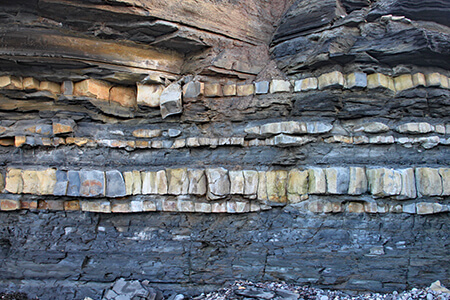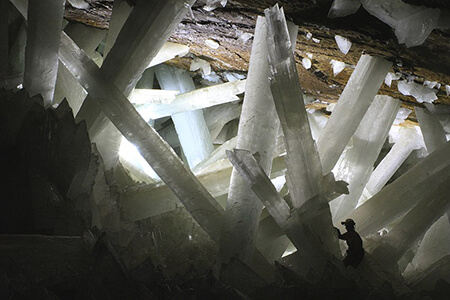This is a lesson summary. The full lesson can be viewed by purchasing an online course subscription.
Learning Objective
In this lesson we will learn about the formation of sedimentary rocks and compare clastic, biochemical and chemical sedimentary rocks. We will also look at some common sedimentary rocks and discuss their properties and uses.
Learning Outcomes
By the end of this lesson you will be able to:
- Explain what sedimentary rocks are and describe how they are formed.
- Compare clastic, biochemical and chemical sedimentary rocks.
- Describe the processes of weathering, erosion, deposition and lithification.
- Describe some common clastic, biochemical and chemical sedimentary rocks.
- Discuss some common uses of sedimentary rocks.

(Image: Anthony, Adobe Stock)
Lesson Summary
- Sedimentary rocks are rocks that are formed by the cementing together of sediments or the precipitation of dissolved minerals.
- Sediments are solid materials resulting from the breakdown of other substances.
- Geological sediments (clastic sediments) are derived from weathered rock.
- Biological sediments are derived from dead organisms.
- Sedimentary rocks are divided into three main groups:
- Clastic sedimentary rocks – rocks composed of geological sediments that have been cemented together.
- Biochemical sedimentary rocks (organic sedimentary rocks) – rocks composed of biological sediments that have been cemented together.
- Chemical sedimentary rocks – rocks formed when dissolved minerals precipitate out of solution.
- The formation of clastic sedimentary rocks takes place in stages.
- Weathering – the physical and chemical breakdown of pre-existing rocks into smaller pieces, which occurs by a variety of processes, including:
- Action of wind, water and glaciers.
- Temperature changes.
- Expansion of ice and formation of crystals.
- Plant and animal activity.
- Chemical processes.
- Erosion – the transport of sediments that result from weathering.
- Agents of erosion include wind, water, ice and gravity.
- Deposition (sedimentation) – the settling of eroded sediments in a new location.
- Deposited sediments form horizontal layers called beds.
- Lithification – the formation of sedimentary rock as a result of compaction and cementation of sediments.
- Compaction is the reduction in space between sediments as a result of gravitational force.
- Cementation is the joining together of sediments as a result of the precipitation of dissolved minerals.
- The formation of biochemical sedimentary rocks occurs in a similar manner to the formation of clastic sedimentary rocks – deposited biological sediments are transformation into biochemical rock by the processes of compaction and cementation.
- The formation of chemical sedimentary rocks occurs when dissolved minerals precipitate out of solution – this involves the processes of evaporation and crystallisation, rather than compaction and cementation.
- Layers of chemical sedimentary rock are called evaporite deposits.
- Since sedimentary rocks do not contain interlocking crystals, they are generally soft, meaning they break apart and crumble easily.
- Clastic sedimentary rock contains grains of varying sizes and consist of visible layers that reflect the deposition of different sediments over time. These layers may contain fossils.
- Examples of clastic sedimentary rocks include sandstone, mudstone, shale, conglomerate and breccia.
- Biochemical sedimentary rock contains biological sediments of varying sizes. It may consist of visible layers and may contain fossils.
- Examples of biochemical sedimentary rocks include limestone, diatomite, coal and oil shale.
- Chemical sedimentary rock usually has a crystalline structure. It rarely exhibits layering.
- Examples of chemical sedimentary rocks include rock salt, gypsum rock and oolitic limestone.
- Sedimentary rocks have a variety of uses, including being used as raw materials in construction, industry and agriculture.

(Image: Alexander Van Driessche, Wikimedia Commons)
(Header image: Vastram, Adobe Stock)
